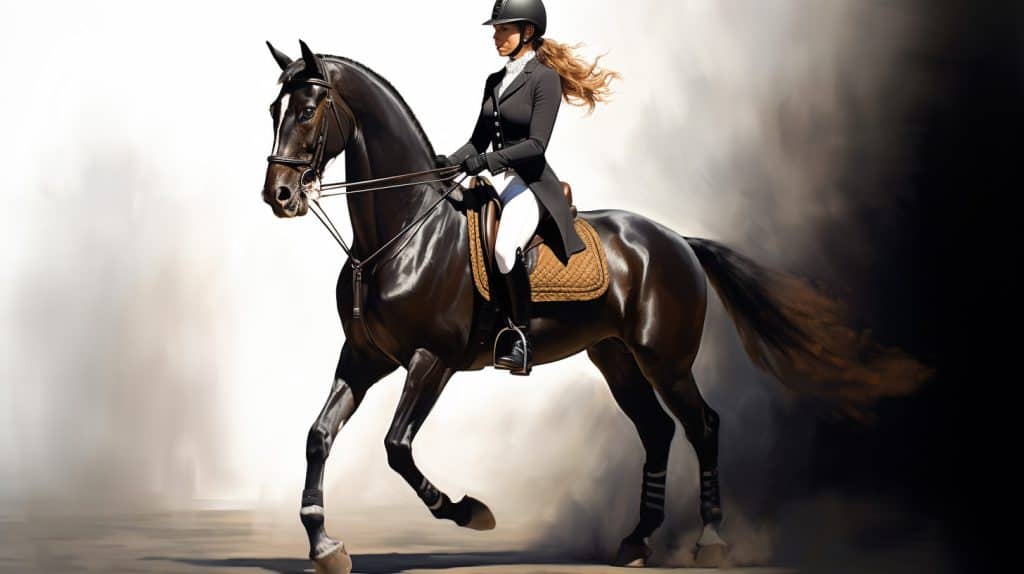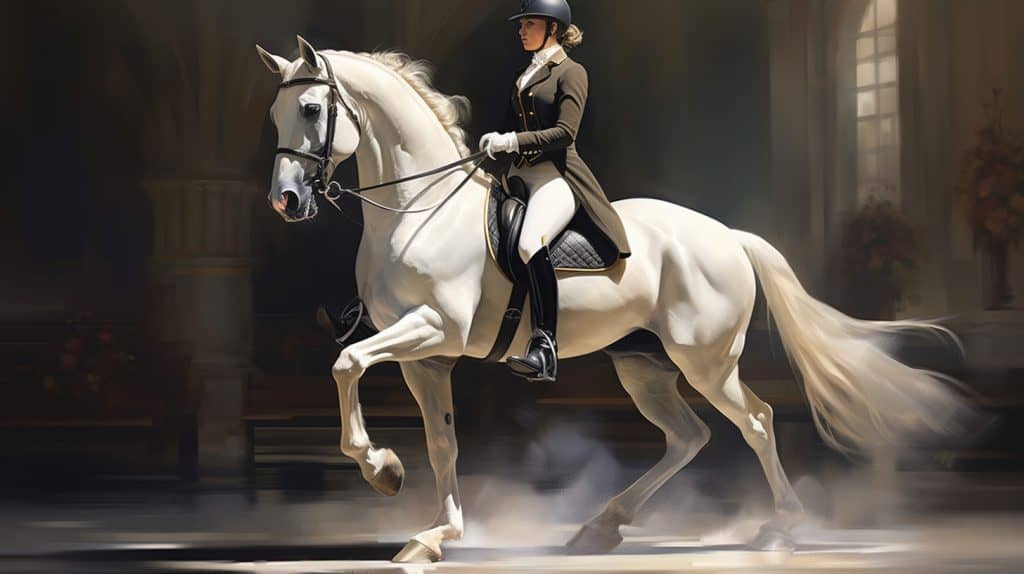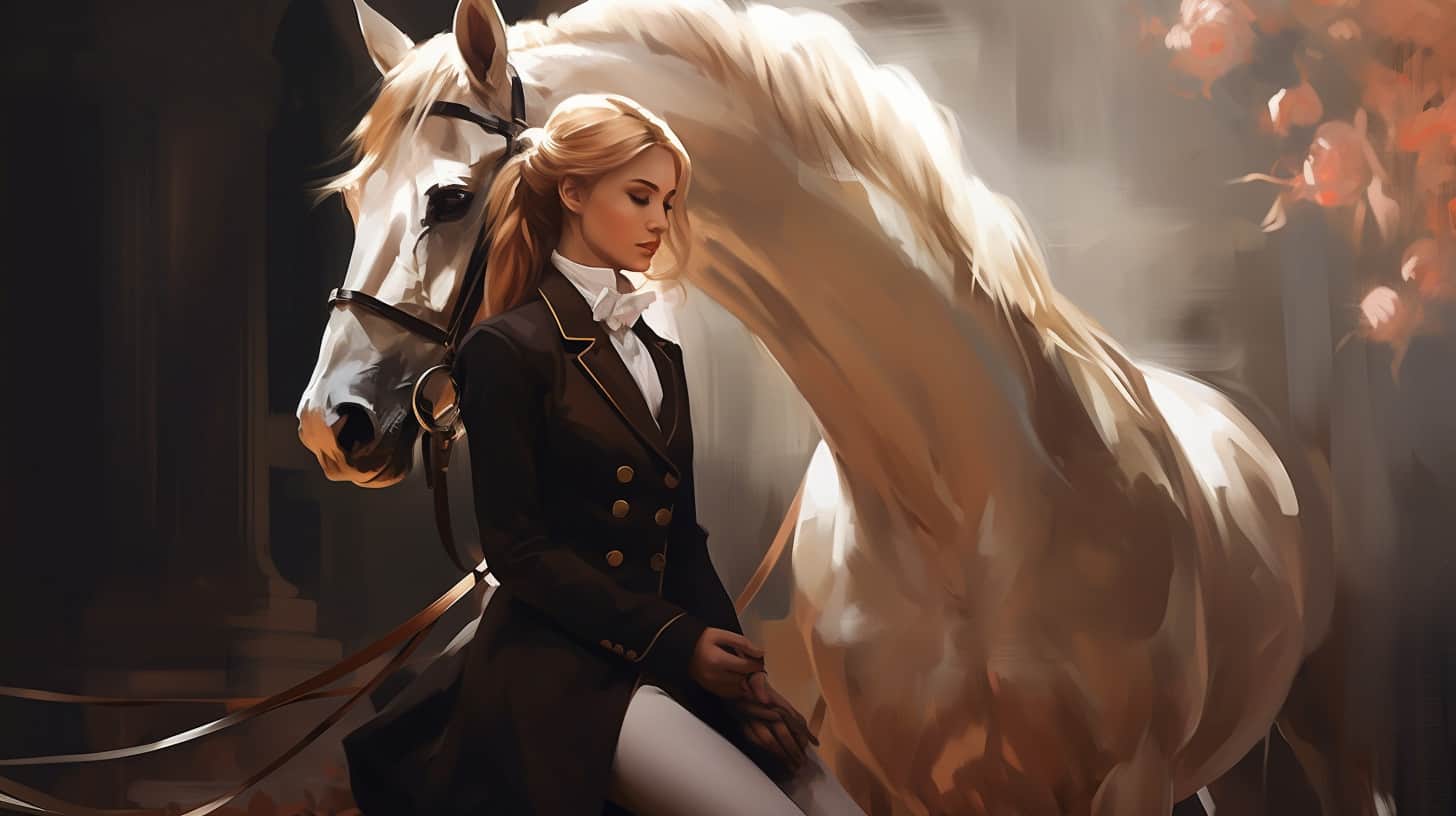Introduction
The equestrian world is a diverse one, with many different styles of riding and cultures that are represented. One of the biggest clashes of cultures in the world of horses is between Western dressage and English dressage. Both of these disciplines have their own unique benefits and challenges, and it’s important to understand the differences between them before making a decision on which is right for you and your horse. In this blog post, we’ll explore the key differences between Western Vs English dressage so you can make an informed decision.
What is Dressage?
Dressage, derived from the French word “dresser,” meaning “to train,” is a discipline of horsemanship that focuses on developing a horse’s natural athleticism and obedience. It is often referred to as “horse ballet” due to the intricate movements and harmonious partnership between horse and rider. Dressage has a rich history and is deeply rooted in classical horsemanship.
Find out how powerful Clydesdales make showstopping performances in the arena and how they impact the dressage world Here .
.
In dressage, the horse is trained to respond to subtle aids from the rider, with the goal of achieving fluid and precise movements. The horse should move freely and rhythmically, demonstrating balance, suppleness, and impulsion. The rider must have a solid position, clear communication, and an understanding of the horse’s biomechanics.
Western dressage and English dressage are two distinct styles of dressage. English dressage originated in Europe and is the more traditional form, with its roots dating back to ancient Greece. Western dressage, on the other hand, is a more recent development that combines elements of Western riding with the principles of dressage.
Both styles share the same basic principles of dressage, but there are some differences in equipment and attire. English dressage is traditionally performed in a snaffle bit and a dressage saddle, while Western dressage allows for the use of a Western saddle and Western tack. Additionally, attire in English dressage typically consists of a helmet, breeches, and tall boots, while Western dressage riders may wear a cowboy hat, jeans, and Western boots.
The History of Western and English Dressage
The history of Western and English dressage is a fascinating journey through the evolution of equestrian culture.
English dressage, with its classical roots dating back to ancient Greece, has a long and storied history. It was originally developed as a method of training horses for war, focusing on the development of precise movements and obedience. Over time, it transformed into an art form, with the horse and rider performing intricate movements together in perfect harmony.

In contrast, western dressage is a more recent development that emerged as a response to the growing popularity of Western riding styles. It combines the principles of traditional dressage with the techniques and equipment of Western riding. Western dressage has gained traction in recent years, with the establishment of organizations such as the Western Dressage Association of America, which promotes and supports the discipline.
is a more recent development that emerged as a response to the growing popularity of Western riding styles. It combines the principles of traditional dressage with the techniques and equipment of Western riding. Western dressage has gained traction in recent years, with the establishment of organizations such as the Western Dressage Association of America, which promotes and supports the discipline.
Both styles of dressage have their own unique training methods and equipment. English dressage typically utilizes a snaffle bit and a dressage saddle, while Western dressage allows for the use of a Western saddle and Western tack. The movements and gaits in each style are also slightly different, with Western dressage focusing more on ranch work movements and the natural way of going for the Western horse.
Training Methods and Equipment in Western vs English Dressage
When it comes to the training methods and equipment used in Western and English dressage, there are a few key differences that set the two styles apart. In terms of training methods, both styles follow the principles of dressage, focusing on developing the horse’s natural athleticism and obedience. However, there are slight variations in the emphasis placed on certain movements and techniques.
In Western dressage, the training methods often incorporate elements of Western riding styles, such as the use of natural horsemanship techniques and ranch work movements. This style puts an emphasis on the horse’s natural way of going and the partnership between horse and rider. The training methods in English dressage, on the other hand, are more focused on precision and technical movements, with an emphasis on developing the horse’s balance, suppleness, and impulsion.
Movement and Gaits in Western and English Dressage
In both Western and English dressage, movement and gaits play a crucial role in the overall performance and success of the horse and rider. However, there are some distinct differences in the way these two styles approach and prioritize movement and gaits.

In English dressage, the focus is often on precision and technicality. The horse is trained to move with grace and elegance, displaying fluidity and rhythm in each movement. The gaits commonly seen in English dressage include the walk, trot, canter, and occasionally the extended trot and collected canter. The horse’s movement should be elevated, with the hindquarters engaged and the front end light and supple. Achieving a balanced and cadenced canter is of utmost importance in the higher levels of English dressage, showcasing the horse’s athleticism and ability to collect and extend its stride.
On the other hand, western dressage places a greater emphasis on the natural way of going for the Western horse. This style often incorporates ranch work movements, such as the jog and lope. The jog is a slow, collected trot that demonstrates the horse’s balance and smoothness of gait, while the lope is a relaxed and flowing canter. The goal of Western dressage is to achieve a balanced, relaxed, and efficient way of moving that is suitable for long hours in the saddle. The horse should exhibit a consistent rhythm and softness in its movements, reflecting the harmony and partnership between horse and rider.
Competitive Differences and Goals in Western and English Dressage
When it comes to competitive differences and goals in Western and English dressage , there are some distinct factors to consider. In English dressage, the focus is often on precision and technicality. Riders strive for elegance and grace in each movement, aiming for fluidity and rhythm. Dressage competitions in the English discipline require riders to demonstrate elevated gaits, engage the hindquarters, and maintain a light and supple front end. The ultimate goal in English dressage is to achieve a balanced and cadenced canter, showcasing the horse’s athleticism and ability to collect and extend its stride.
, there are some distinct factors to consider. In English dressage, the focus is often on precision and technicality. Riders strive for elegance and grace in each movement, aiming for fluidity and rhythm. Dressage competitions in the English discipline require riders to demonstrate elevated gaits, engage the hindquarters, and maintain a light and supple front end. The ultimate goal in English dressage is to achieve a balanced and cadenced canter, showcasing the horse’s athleticism and ability to collect and extend its stride.
On the other hand, western dressage takes a different approach. This style places a greater emphasis on the natural way of going for the Western horse, incorporating ranch work movements such as the jog and lope. The goal in Western dressage competitions is to achieve a balanced, relaxed, and efficient way of moving that is suitable for long hours in the saddle. Judges evaluate the consistency of rhythm, softness of movement, and harmony between horse and rider.
Popular Misconceptions and Criticisms of Both Styles
There are often popular misconceptions and criticisms surrounding both Western and English dressage. One common misconception is that Western dressage is simply a watered-down version of traditional English dressage. Hence The Western vs English Dressage characterization. However, this is far from the truth. Western dressage has its own set of training methods, equipment, and movements that make it a distinct discipline within the equestrian world.

Another misconception is that dressage is only for high-level competitors or Olympic-level riders. While dressage can certainly be competitive at the highest levels, it is also accessible to riders of all skill levels and aspirations. Whether you are a beginner looking to improve your partnership with your horse or an experienced rider looking to refine your skills, dressage can offer something for everyone.
Critics of both styles often argue that dressage is too focused on aesthetics and movements that are not natural for the horse. However, dressage  is actually rooted in the development of the horse’s natural athleticism and obedience. Both Western and English dressage aims to improve the horse’s balance, suppleness, and impulsion, resulting in a more harmonious partnership between horse and rider.
is actually rooted in the development of the horse’s natural athleticism and obedience. Both Western and English dressage aims to improve the horse’s balance, suppleness, and impulsion, resulting in a more harmonious partnership between horse and rider.
Can the Two Styles Coexist or Converge?
In the world of dressage, there is often a divide between Western and English styles. Many people wonder if the two styles can coexist or even converge. The answer is, absolutely! While Western and English dressage have their own unique characteristics and traditions, there is room for appreciation and understanding between the two.
One way the two styles can coexist is through participation in dressage competitions. Dressage competitions provide a platform for riders of both Western and English disciplines to showcase their skills and talent. These competitions often have different divisions and classes that cater to each style, allowing riders to compete against others who ride in a similar fashion. This not only promotes healthy competition but also fosters a sense of unity and camaraderie among equestrians.
Furthermore, there is also an opportunity for convergence between the two styles. As the equestrian world evolves and riders seek to expand their horizons, there is a growing interest in combining elements of Western and English dressage. This fusion allows riders to incorporate the best of both worlds, blending the precision and technicality of English dressage with the natural way of going and partnership emphasized in Western dressage. The result is a unique and harmonious approach to dressage that celebrates the versatility and adaptability of the horse and rider.

What are the Different Levels of Horse Dressage?
In the world of dressage, there are various levels that horses and riders can progress through as they develop their skills and abilities. These levels are designed to challenge both horse and rider and provide a clear progression in their training. Whether you are pursuing Western or English dressage, understanding the different levels can help you set goals and measure your progress.
In both Western and English dressage, there are typically four main levels: introductory, training, first, and second. Each level builds upon the previous one, introducing new movements, patterns, and challenges.
The introductory level is where riders and horses start their dressage journey, focusing on basic movements and developing a strong foundation. As riders and horses progress, they move up to the training level, where they refine their skills and begin to tackle more complex movements. The first and second levels continue to build upon the skills and movements learned in the previous levels, with increasing difficulty and technicality.
is where riders and horses start their dressage journey, focusing on basic movements and developing a strong foundation. As riders and horses progress, they move up to the training level, where they refine their skills and begin to tackle more complex movements. The first and second levels continue to build upon the skills and movements learned in the previous levels, with increasing difficulty and technicality.
At each level, riders have the opportunity to compete in dressage shows and competitions. These events allow riders to showcase their skills and receive feedback from judges. Dressage competitions are divided into different divisions and classes, based on the rider’s skill level and the horse’s experience. This allows riders to compete against others who are at a similar level, providing a fair and competitive environment.
Regardless of the level, training is a key component of dressage. This is where Western vs English dressage doesn’t exist. Both Western and English dressage requires dedicated training, focusing on the development of the horse’s natural athleticism and obedience. It is important for riders to understand the specific training methods and equipment used in their chosen style, whether it be the use of a dressage saddle and snaffle bit in English dressage or a Western saddle and Western tack in Western dressage.
As you progress through the levels of dressage, it is important to continue your education and seek guidance from experienced trainers and coaches. They can provide valuable feedback and help you refine your skills and techniques. Additionally, attending dressage clinics and workshops can provide further opportunities for learning and growth.
Western and English Competitions
Dressage competitions are a vibrant and exciting part of both Western and English dressage. These events provide an opportunity for riders to showcase their skills, compete against others, and receive valuable feedback from experienced judges.
In dressage competitions, riders perform a series of predetermined movements and patterns, demonstrating their horse’s training and ability. The movements and requirements may differ slightly between Western and English dressage, but the overarching goal remains the same: to display a harmonious partnership between horse and rider.

Competing in dressage requires careful preparation and training. Riders must develop their horse’s natural athleticism and obedience, focusing on precision, balance, and rhythm. Both Western vs English dressage riders must adhere to specific training methods and utilize appropriate equipment, such as a dressage saddle and snaffle bit for English dressage or a Western saddle and Western tack for Western dressage.
Dressage competitions are divided into different divisions and classes based on the rider’s skill level and the horse’s experience. This ensures a fair and competitive environment, allowing riders to compete against others who are at a similar level. It also provides an opportunity for growth and learning, as riders receive valuable feedback from judges and can identify areas for improvement.
Attending dressage competitions not only allows riders to measure their progress but also fosters a sense of camaraderie and community among equestrians. These events bring together riders from different backgrounds and styles, united by their love for dressage. Whether it’s the elegance and precision of English dressage or the fusion of Western and classical techniques in Western dressage, dressage competitions provide a platform for riders to celebrate their achievements and connect with fellow enthusiasts.
So, whether you are a seasoned competitor or new to the dressage world, consider participating in dressage competitions to test your skills, learn from experienced judges, and embrace the thrill of the competition. Dressage shows offer an invaluable opportunity to grow as a rider and develop a deeper bond with your horse.

Conclusion
In conclusion, the clash between Western vs English dressage showcases the diversity and richness of the equestrian world. Both styles have their own unique benefits, challenges, and traditions.
Understanding the differences between them is essential for making an informed decision about which style is right for you and your horse.
Western dressage combines the principles of traditional dressage with Western riding styles, focusing on the natural way of going for the Western horse. English dressage, on the other hand, emphasizes precision, technicality, and elegance in each movement. Both styles require dedicated training, the use of specific equipment such as dressage saddles or Western tack, and the development of a harmonious partnership between horse and rider.
Competing in dressage shows is a great way to measure progress and receive valuable feedback from judges. These events offer riders the chance to showcase their skills and connect with fellow equestrians in a supportive and competitive environment. Dressage competitions are divided into different divisions and classes, ensuring fair competition and opportunities for growth.
Whether you choose to pursue Western or English dressage, it’s important to remember that dressage is about more than flashy movements or fads. It is rooted in the development of the horse’s natural ability and obedience. Both styles offer a rewarding journey of learning, growth, and a deep connection with your equine partner. Therefore yes there is going to be that Western Vs English dressage in your head whether to choose one or the other but you need to make an informed decision for both dressage horse and dressage rider.
So, embrace the challenge, set your goals, and enjoy the unique journey of dressage, whether it be in the elegance and precision of English dressage or the fusion of Western and classical techniques in Western dressage. The equestrian world is vast and diverse, and so Western vs English dressage has its own place in it.
Recent Posts
Mastering English Dressage: Tips and Techniques Complete Guide 101
Introduction English dressage is an equestrian sport that involves precise movements and commands between a dressage horse and its rider. It is a graceful, beautiful art form that requires skill...
Introduction Are you looking to learn more about western dressage, the art of horse dressage? If so, you've come to the right place. In the previous blog we looked at Western vs English Dressage,...

